Abstract
The heparin content of genetically selected mice with high and low antibody response to bacterial antigens is reported. An inverse relationship between antibody titres and concentration of heparin was observed for both male and female mice. The lower-antibody-responder line contains twice as much heparin as the higher-responder ones. Furthermore, the female mice also contained twice as much heparin as the male mice. Genetic analysis of the parental and interline hybrids has shown a partial dominance for the character 'heparin content' in favour of the high-heparin phenotype and this character appears to be subjected to polygenic control. The possible biological role of heparin and/or mast cells in the surveillance of the organism against some pathogens is discussed in the light of these and other findings.
Full text
PDF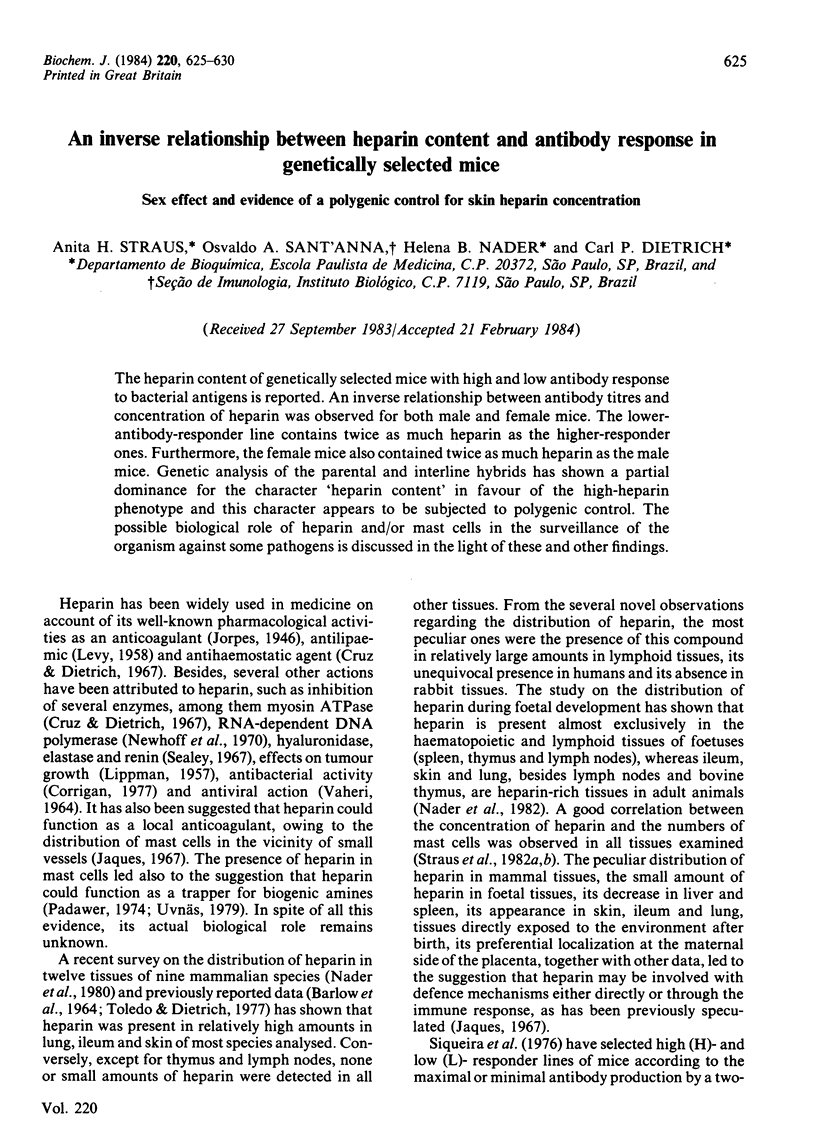
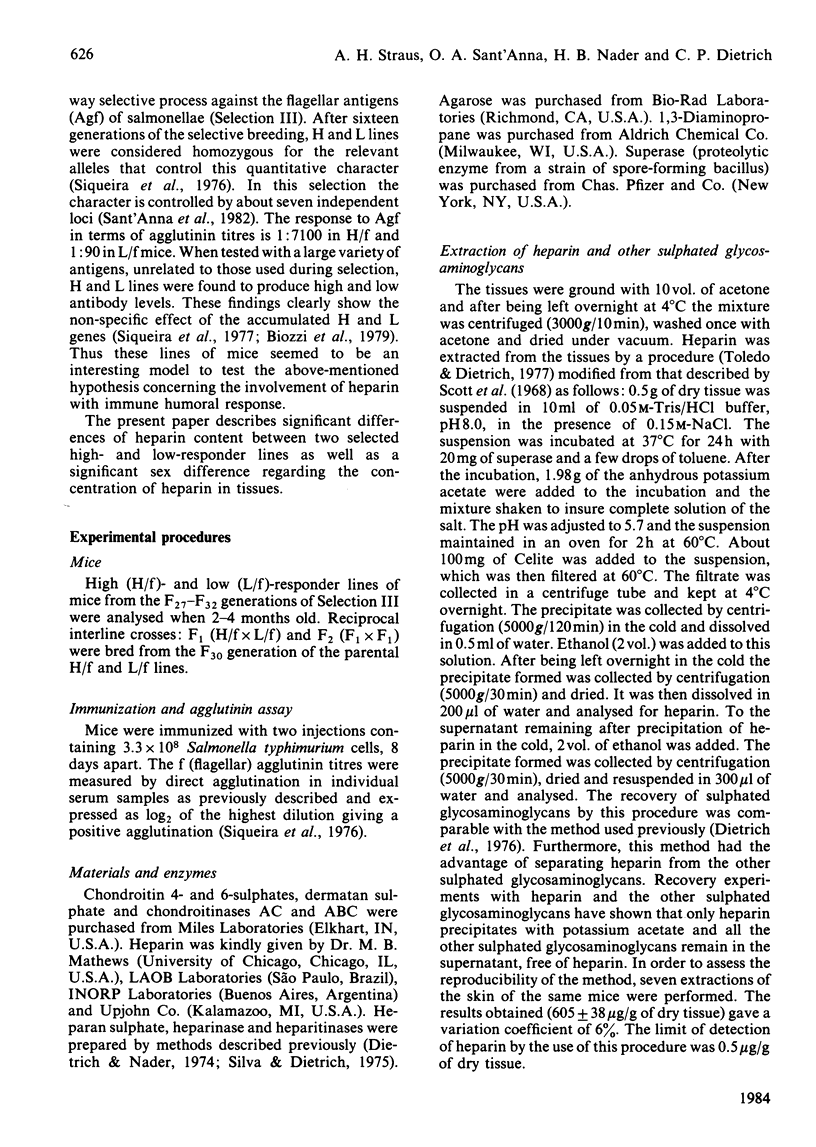
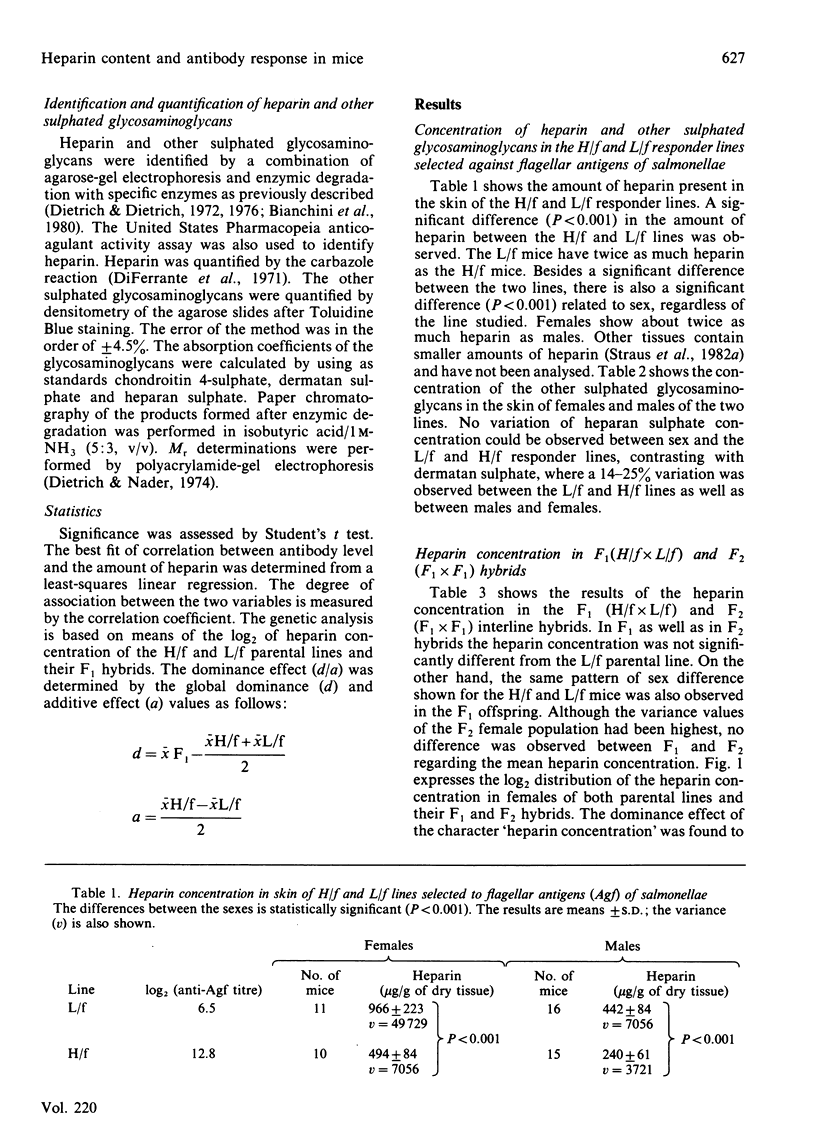
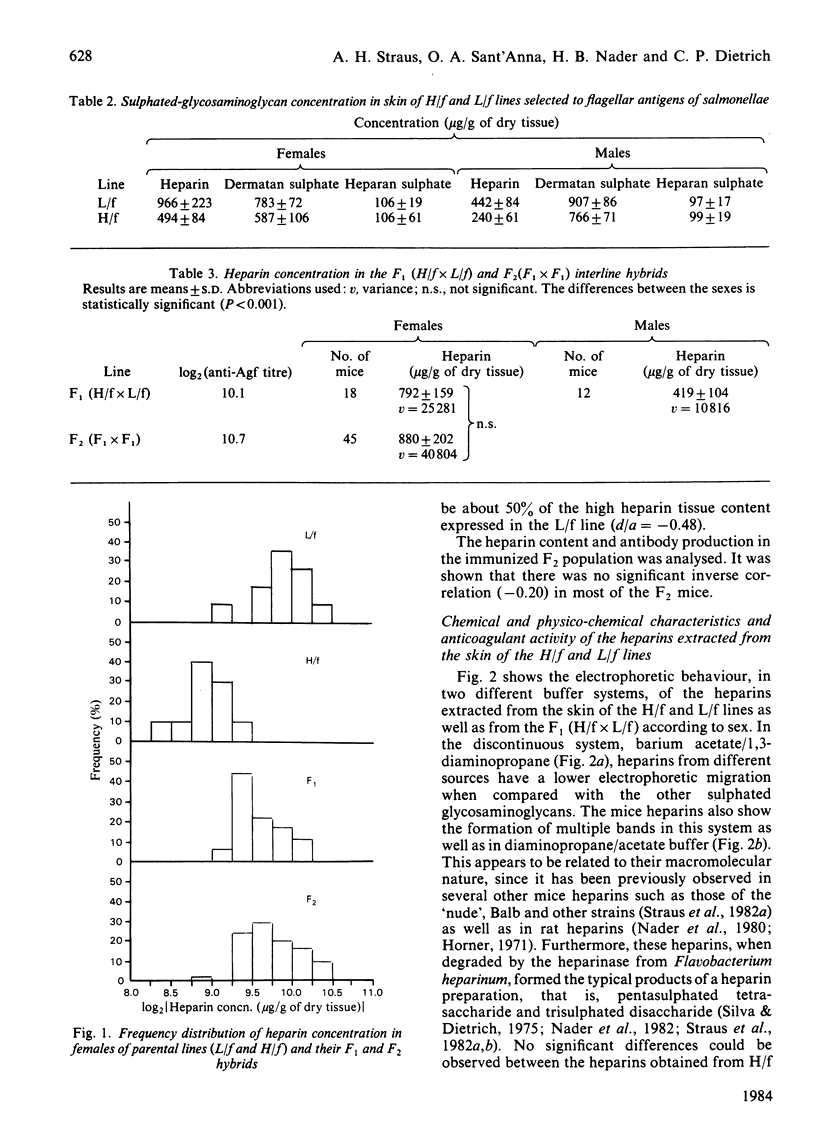
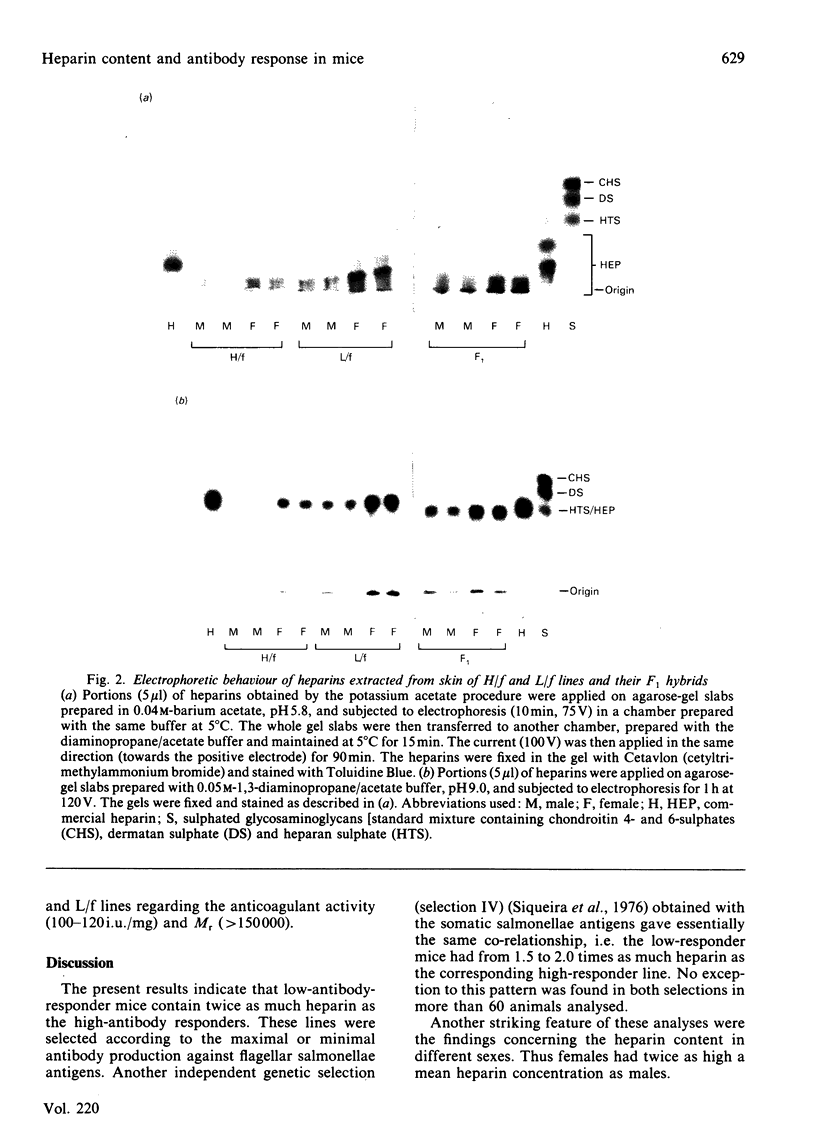
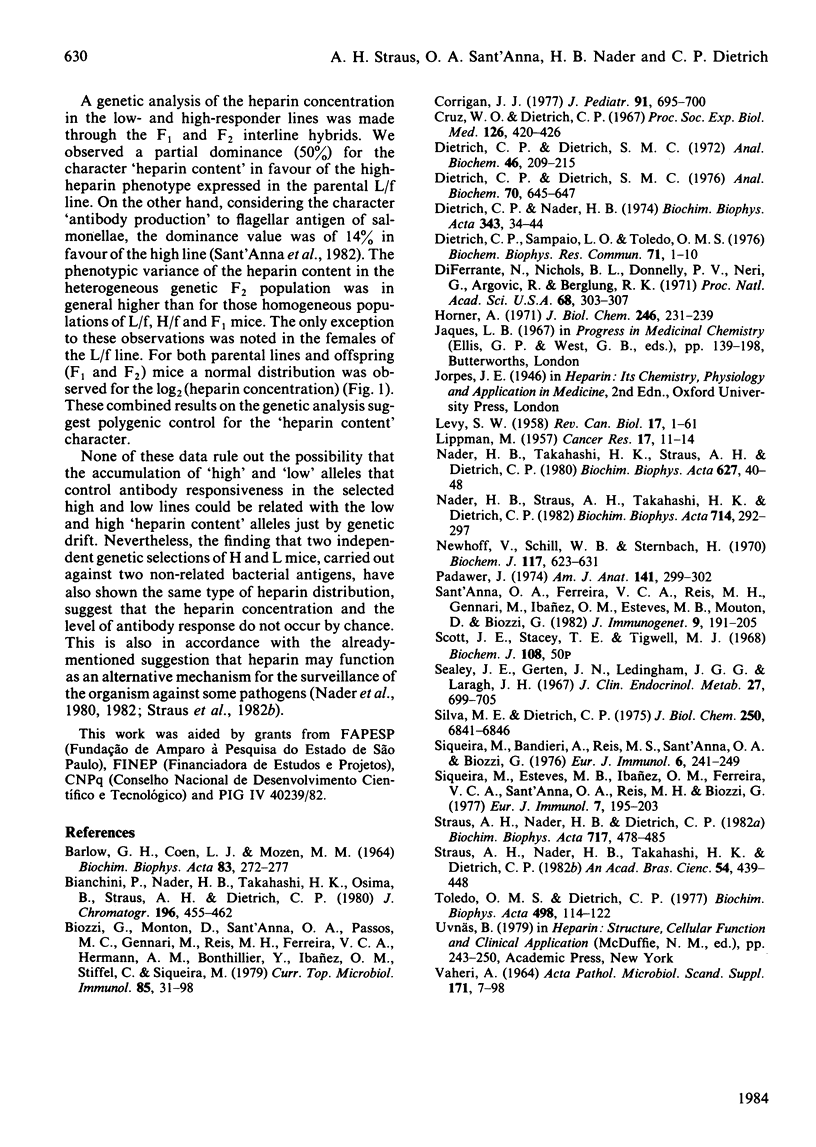
Images in this article
Selected References
These references are in PubMed. This may not be the complete list of references from this article.
- BARLOW G. H., COEN L. J., MOZEN M. M. A BIOLOGICAL, CHEMICAL AND PHYSICAL COMPARISON OF HEPARIN FROM DIFFERENT MAMMALIAN SPECIES. Biochim Biophys Acta. 1964 Nov 1;83:272–277. doi: 10.1016/0926-6526(64)90004-7. [DOI] [PubMed] [Google Scholar]
- Biozzi G., Mouton D., Sant'Anna O. A., Passos H. C., Gennari M., Reis M. H., Ferreira V. C., Heumann A. M., Bouthillier Y., Ibanez O. M. Genetics of immunoresponsiveness to natural antigens in the mouse. Curr Top Microbiol Immunol. 1979;85:31–98. [PubMed] [Google Scholar]
- Corrigan J. J., Jr Heparin therapy in bacterial septicemia. J Pediatr. 1977 Nov;91(5):695–700. doi: 10.1016/s0022-3476(77)81017-2. [DOI] [PubMed] [Google Scholar]
- Cruz W. O., Dietrich C. P. Antihemostatic effect of heparin counteracted by adenosine triphosphate. Proc Soc Exp Biol Med. 1967 Nov;126(2):420–426. doi: 10.3181/00379727-126-32465. [DOI] [PubMed] [Google Scholar]
- Di Ferrante N., Nichols B. L., Donnelly P. V., Neri G., Hrgovcic R., Berglund R. K. Induced degradation of glycosaminoglycans in Hurler's and Hunter's syndromes by plasma infusion. Proc Natl Acad Sci U S A. 1971 Feb;68(2):303–307. doi: 10.1073/pnas.68.2.303. [DOI] [PMC free article] [PubMed] [Google Scholar]
- Dietrich C. P., Dietrich S. M. Electrophoretic behaviour of acidic mucopolysaccharides in diamine buffers. Anal Biochem. 1976 Feb;70(2):645–647. doi: 10.1016/0003-2697(76)90496-6. [DOI] [PubMed] [Google Scholar]
- Dietrich C. P., Dietrich S. M. Simple micro method for identification of heparin and other acidic mucopolysaccharides from mammalian tissues. Anal Biochem. 1972 Mar;46(1):209–215. doi: 10.1016/0003-2697(72)90413-7. [DOI] [PubMed] [Google Scholar]
- Dietrich C. P., Nader H. B. Fractionation and properties of four heparitin sulfates from beef lung tissue. Isolation and partial characterization of a hemogeneous species of heparitin sulfate. Biochim Biophys Acta. 1974 Mar 20;343(1):34–44. doi: 10.1016/0304-4165(74)90237-2. [DOI] [PubMed] [Google Scholar]
- Dietrich C. P., Sampaio L. O., Toledo O. M. Characteristic distribution of sulfated mucopolysaccharides in different tissues and in their respective mitochondria. Biochem Biophys Res Commun. 1976 Jul 12;71(1):1–10. doi: 10.1016/0006-291x(76)90241-2. [DOI] [PubMed] [Google Scholar]
- Horner A. A. Macromolecular heparin from rat skin. Isolation, characterization, and depolymerization with ascorbate. J Biol Chem. 1971 Jan 10;246(1):231–239. [PubMed] [Google Scholar]
- Jaques L. B. The pharmacology of heparin and heparinoids. Prog Med Chem. 1967;5:139–198. doi: 10.1016/s0079-6468(08)70443-0. [DOI] [PubMed] [Google Scholar]
- LEVY S. W. Heparin and blood lipids. Rev Can Biol. 1958 Feb;17(1):1–61. [PubMed] [Google Scholar]
- LIPPMAN M. The growth-inhibitory action of heparin on the Ehrlich ascites tumor in mice. Cancer Res. 1957 Jan;17(1):11–14. [PubMed] [Google Scholar]
- Nader H. B., Straus A. H., Takahashi H. K., Dietrich C. P. Selective appearance of heparin in mammalian tissues during development. Biochim Biophys Acta. 1982 Feb 2;714(2):292–297. doi: 10.1016/0304-4165(82)90336-1. [DOI] [PubMed] [Google Scholar]
- Nader H. B., Takahashi H. K., Straus A. H., Dietrich C. P. Selective distribution of the heparin in mammals: conspicuous presence of heparin in lymphoid tissues. Biochim Biophys Acta. 1980 Jan 3;627(1):40–48. doi: 10.1016/0304-4165(80)90121-x. [DOI] [PubMed] [Google Scholar]
- Neuhoff V., Schill W. B., Sternbach H. Micro-analysis of pure deoxyribonucleic acid-dependent ribonucleic acid polymerase from Escherichia coli. Action of heparin and rifampicin on structure and function. Biochem J. 1970 Apr;117(3):623–631. doi: 10.1042/bj1170623. [DOI] [PMC free article] [PubMed] [Google Scholar]
- Padawer J. Editorial: The ins and outs of mast cell function. Am J Anat. 1974 Nov;141(3):299–302. doi: 10.1002/aja.1001410302. [DOI] [PubMed] [Google Scholar]
- Sant'Anna O. A., Ferreira V. C., Reis M. H., Gennari M., Ibañez O. M., Esteves M. B., Mouton D., Biozzi G. Genetic parameters of the polygenic regulation of antibody responsiveness to flagellar and somatic antigens of salmonellae. J Immunogenet. 1982 Jun;9(3):191–205. doi: 10.1111/j.1744-313x.1982.tb00791.x. [DOI] [PubMed] [Google Scholar]
- Sealey J. E., Gerten J. N., Ledingham J. G., Laragh J. H. Inhibition of renin by heparin. J Clin Endocrinol Metab. 1967 May;27(5):699–705. doi: 10.1210/jcem-27-5-699. [DOI] [PubMed] [Google Scholar]
- Silva M. E., Dietrich C. P. Structure of heparin. Characterization of the products formed from heparin by the action of a heparinase and a heparitinase from Flavobacterium heparinum. J Biol Chem. 1975 Sep 10;250(17):6841–6846. [PubMed] [Google Scholar]
- Siqueira M., Bandieri A., Reis M. S., Sant'anna O. A., Biozzi G. Selective breeding of mice for antibody responsiveness to flagellar and somatic antigens of salmonellae. Eur J Immunol. 1976 Apr;6(4):241–249. doi: 10.1002/eji.1830060403. [DOI] [PubMed] [Google Scholar]
- Siqueira M., Esteves M. B., Ibanez O. M., Ferreira V. A., Sant'Anna O. A., Reis M. H., Biozzi G. Nonspecific genetic regulation of antibody responsiveness in the mouse. Eur J Immunol. 1977 Apr;7(4):195–203. doi: 10.1002/eji.1830070402. [DOI] [PubMed] [Google Scholar]
- Straus A. H., Nader H. B., Dietrich C. P. Absence of heparin or heparin-like compounds in mast-cell-free tissues and animals. Biochim Biophys Acta. 1982 Aug 27;717(3):478–485. doi: 10.1016/0304-4165(82)90291-4. [DOI] [PubMed] [Google Scholar]
- Straus A. H., Nader H. B., Takahashi H. K., Dietrich C. P. Ontogeny of heparin in mammals: a correlation with the appearance of mast cells in tissues. An Acad Bras Cienc. 1982 Jun;54(2):439–448. [PubMed] [Google Scholar]
- Toledo O. M., Dietrich C. P. Tissue specific distribution of sulfated mucopolysaccharides in mammals. Biochim Biophys Acta. 1977 Jun 23;498(1):114–122. doi: 10.1016/0304-4165(77)90092-7. [DOI] [PubMed] [Google Scholar]



